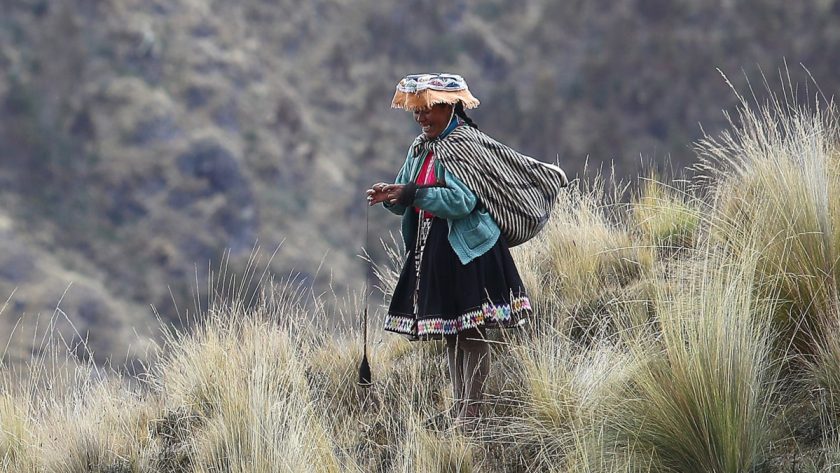If you pulled a thread from an alpaca wool sweater and traced the fiber all the way back to its origins, you’d probably end up very high on a Peruvian mountainside.
Peru is home to the largest population of the camelids, which are basically the Latin American cousin of a camel and are prized for their fuzzy furs. Alpacas power at least 16% of the country’s textile export industry, according to the Commission for the Promotion of Peru for Exports and Tourism (PromPeru), and their fibers bring in north of $100 million annually.
Despite the country being the central hub for alpaca production, things haven’t been the same since the pandemic, which affected consumers and individuals working down the supply chain alike. There were only $110 million in alpaca exports in 2020, compared to $158 million the year before, based on figures shared by PromPeru. Exports from 2022 were even lower, at $102 million.
PromPeru is aiming to generate interest in Peruvian alpaca through Peru Moda and Deco, which is like a trade show and fashion show in one. Angélica Matsuda, the organization’s executive president, says the “fundamental challenge” is that alpaca is still not as well-known globally as other knit fibers, like cashmere.
“People may have heard about it, but it’s one thing to know it exists versus to touch it and know its properties,” she says. “We want people to understand it more: where it’s from, what it feels like, how to care for it.”
Back in 2014, the Trade Commission of Peru did a big marketing push to familiarize the public with alpaca, incentivizing designers to use it in their New York Fashion Week collections. Almost a decade later, PromPeru is introducing a new effort: a label that designates pieces made with the fiber as “Alpaca del Peru,” “so that people get more familiar and know where it’s from,” according to Matsuda.
Another major concern regarding the alpaca industry’s reinvigoration is a desire to improve conditions for alpaca farmers, who are the often-underpaid backbone of the industry and, accordingly, need livable pay and better infrastructure to continue to support the sector’s growth. It’s been part of an ongoing thread of social upheaval seen throughout Peru in the last few years.
Photo: Leonardo Fernandez/Getty Images
According to Jose Calderon, manager of Natural Yarns Peru, alpaca farmers are often paid about 15 Peruvian soles (equivalent to about $4) per kilo of fiber by middlemen who then sell it to larger companies, like Michell Group and Inca Tops. By the end of production, a 100% alpaca sweater may be sold to the consumer for hundreds of dollars.
“That has to get better,” says Jesus Petrona Candia Mongado, the region president of Mujeres Aymaras Yapuchiri, an organization that trains Aymara women in Peru’s Puno region across business and crafts with the aim of lifting them out of poverty. “I think it’d be better if farmers could sell the yarn. You can transform it with machines, but many lack the machine.”
Natural Yarns Peru creates the machines that enable farmers to turn their own shavings into hand-spun yarn, with the goal of helping them earn more money from the raw material. It’s important, surely, but more needs to be done to help farmers have access to the infrastructure necessary to not just survive, but thrive.
“Alpaca farmers need a better quality of life,” says Innovative Knitwear CEO Eunice Moran. “But basic resources don’t usually get that high, like internet and electricity.”
“Where alpacas grow, it’s very high up,” Peruvian designer Annaiss Yucra affirms. “If people are working with alpacas, it’s because their land is not suitable for anything else, like growing vegetables.”
Aside from bringing information technology and electricity to the people who live and work at higher altitudes (which is something the government has to do), Mongado adds that stronger infrastructure could help keep more young people on the farms, versus moving closer to urban areas where resources like internet are present.
Alonso Burgos, founder and head of Pacomarca Sustainable Alpaca Network, is focused on improving farmer conditions through its network of homesteads. He also stresses the importance of studying alpaca genetics and improving the quality of their fiber to increase its monetary appraisal. (He’s working with leading Peruvian universities to research selective breeding and alpaca hair construction, in order to develop hairs that will feed into a softer, more luxurious final product.)
“The alpaca and its fibers that we have today is probably only at 50% of its full potential in terms of what we could achieve,” Burgos says. “Can you imagine how much development there could be? It’s a dream, but it’s a perfectly reasonable dream.”
The brands buying and using alpaca also have a role to play. They can seek out certifications like the Textile Exchange’s Responsible Alpaca Standard, which promote animal welfare in the supply chain. Though, these benchmarks only trickle down so far down.
There’s no doubt that alpaca fiber has many appealing qualities as-is. Thanks to the animals’ migration to higher altitudes, their hair can wick moisture and is suitable for a wide range of temperatures. And while it’s already favored by a range of designers, both in Peru and abroad, there’s still a long road to hitting export dollars like pre-pandemic years. The industry will certainly need to attract more attention — but success won’t just hinge on that, with farmers’ survival essential to its future.
Disclosure: PromPerú paid for Fashionista’s travel and accommodations to attend Peru Moda Deco and visit the Pacomarca farm.
Want the latest fashion industry news first? Sign up for our daily newsletter.



